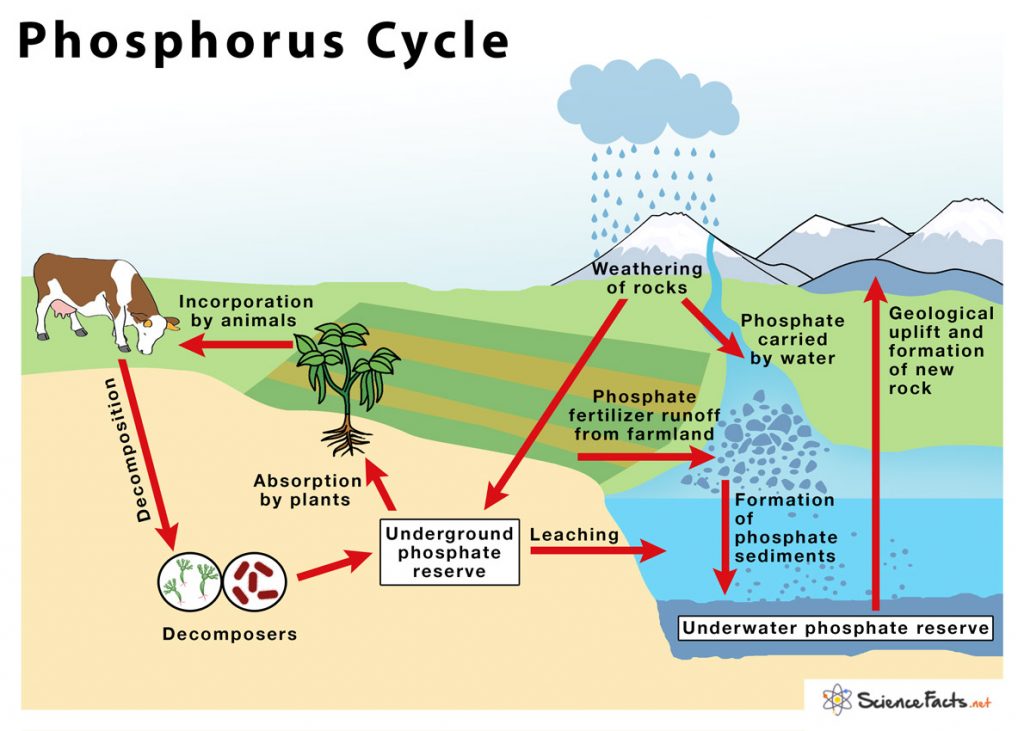Phosphorus Cycle
What is the phosphorus cycle?
Biogeochemical process showing the movement of phosphorus and its different forms in nature with the help of living organisms is called the phosphorus cycle.
What are the main sources of phosphorus in the phosphorus cycle?
Rocks, water, soil, and sediments constitute the primary nonliving sources of phosphorus, whereas plants and animals form the major living sources.
What are the five steps of the phosphorus cycle?
1) Weathering
Over a long period, phosphates found in the sedimentary rocks as PO43-, are leached out of the disintegrated rocks from its various environmental sources in the form of inorganic phosphate ions. This process called weathering acts as the first key step of the phosphorus cycle.
Other than weathering, volcanic ash, aerosols, and mineral dust also serve as other significant phosphate sources.
2) Mineralization by plants
Plants absorb organic phosphorus present in soil and underground water and convert them to inorganic forms for utilization is called mineralization.
The aquatic plants absorb inorganic phosphorus from lower layers of water bodies due to their low solubility in water.
3) Assimilation by animals
Herbivorous and carnivorous animals, including humans, absorb phosphorus when they consume these plants for their food, a process known as assimilation. Besides, animals obtain phosphorus directly from drinking water.
4) Decomposition by microorganisms
Microorganisms such as bacteria and fungi decompose organic phosphates back into the inorganic form, which is then returned to the soil and water bodies. Phosphorus-containing compounds may also be carried in the surface runoff to rivers, lakes, and oceans to form sediments.
5) Geological uplift by tectonic movements
Over long periods, sedimentary rocks containing phosphorus may be moved from the ocean to the land by a process called geological uplift. The phosphorus thus deposited as sediments are ultimately released back into the environment through the process of weathering, thus completing the cycle.
Why is the phosphorus cycle important?
- Acts as an essential component of nucleotides and nucleic acids such as DNA and RNA
- Forms an essential component of our bone and the enamel of mammalian teeth
- Constitutes an essential component of the phospholipids present in the biological membranes such as cell membrane
- Forms the exoskeleton structure of insects
- Functions as a buffering agent to maintain a steady physiochemical condition of the body
How do humans affect the phosphorus cycle?
Human activities adversely affect the phosphorus cycle in the following ways:
- Using of phosphate-containing fertilizers
- Cutting down of tropical rain forests
- Spilling of phosphate during transportation
- Leaching of phosphorus from households and industries into water bodies
How does the use of fertilizer affect the phosphorus cycle?
Excessive use of phosphate fertilizers to enrich the soil also potentially increases the phosphorus content of the water bodies through surface runoff. This phenomenon leads to excessive growth of algae, thus lowering the dissolved oxygen level in the water bodies, resulting in severe loss of aquatic lives.
How does deforestation affect the phosphorus cycle?
Cutting down of trees increases soil erosion and thus decrease the phosphorus content of the soil. Since phosphorus acts as a limiting nutrient for plant growth, deforestation affects the phosphorus cycle.
What happens due to fluctuations of the phosphorus cycle in aquatic ecosystems?
An increase in the concentration of phosphorus will considerably boost the growth of algae within that ecosystem, causing a decline of oxygen content in the water, and thus major loss of aquatic life. On the other hand, a decrease in phosphorus concentration will deprive aquatic animals of the nutrient, limiting their growth.
Which parts of the phosphorus cycle are geological processes?
Weathering of rocks (the first step) and geological uplift (the last step) are the two geological processes that are part of the phosphorus cycle.
How is the phosphorus cycle different from the other biogeochemical cycles?
The global phosphorus cycle differs from other nutrient cycles in that it is a slow process and does not include any gaseous phase – a unique feature of this cycle.
How are the carbon and phosphorus cycle different?
Firstly, carbon and phosphorus cycles involve two different elements of carbon and phosphorus, respectively. The other major difference between the two is that the carbon cycle has an atmospheric component as carbon is available in the nature, whereas phosphorus needs to be created through the cycle.
How are the phosphorus and nitrogen cycles different?
The phosphorus cycle does not include an atmospheric component as phosphorus is not available in the nature, whereas nitrogen cycle occurs using the nitrogen in the atmosphere.
Article was last reviewed on Tuesday, March 3, 2020





This website gave me many facts which i did not know and i liked it.
i liked it
This was very useful for my Biology class!!!!!
This was soooooo helpful for my Biology class!!!!
Thank you Science Facts!!! I love you.
I love this website sooo much!!!!
Thank you so much for the work you did on this website it’s great and very factual.
Thank you so much for this great work ❤️
Love it so much